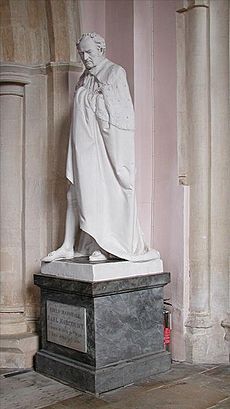Robert William Sievier facts for kids
Robert William Sievier (born July 24, 1794, died April 28, 1865) was a very talented British artist and inventor. He was known for his amazing engravings and sculptures in the 1800s. Later in his life, he also became a clever inventor.
Artist and Sculptor
Robert Sievier showed a natural talent for drawing from a young age. He learned from famous artists like John Young and Edward Scriven. He also studied at the Royal Academy Schools starting in 1818.
He was especially good at making portraits by engraving. This means he would carve designs into metal plates to print pictures. He also created other artworks, including some based on paintings by William Etty.
Around 1823, Sievier decided to focus on sculpture instead of engraving. He made sculptures of important people. These included Prince Albert of Saxe-Coburg and Gotha, who was Queen Victoria's husband. He also sculpted Sir Thomas Lawrence, a famous painter. You can see the sculpture of Sir Thomas Lawrence at the Sir John Soane's Museum.
Sievier also taught other artists. Two of his students were William F Woodington and Musgrave Watson.
He showed his artwork at the Royal Academy from 1822 to 1844. His works there included many busts (sculptures of a person's head and shoulders). He also made full figures, gravestones, and monuments. His first art studio was in London's Southampton Row. In 1837, he moved his studio to Henrietta Street. He also had a separate home in Upper Holloway.
Other Famous Works
- A statue of Charles Dibdin in Greenwich.
- A statue of Field Marshal William Harcourt, 3rd Earl Harcourt. You can find this in Clewer and St George's Chapel at Windsor Castle.
- A bust of Sir John Silvester in the Old Bailey (a famous court building).
- A bust and monument for Sir George Paul. He was a prison reformer. This is in Gloucester Cathedral.
- A portrait bust of Judge Robert Dallas made in 1822.
- A decorated stone front for the Central Avenue of Covent Garden Market Hall. It has urns and a sculpture of Flora.
- A statuette of Captain Thomas Coram at the Foundling Hospital in London.
- A figure of Edward Jenner, who discovered the smallpox vaccination. This is on a pedestal near Gloucester Cathedral.
- Chimney pieces at Chatsworth House in Derbyshire. He made these with Richard Westmacott (the younger) around 1840.
- A monument for himself in Kensal Green Cemetery. Sievier was on the board of this cemetery.
In 1837, he entered a competition to design a monument for Nelson in Trafalgar Square. He worked with architect Charles Fowler and came in third place.
Inventor and Innovator
In 1836, Sievier received a special patent for a new way to make fabrics waterproof using rubber. He started a company called the London Caoutchouc Company. "Caoutchouc" was an old name for India rubber.
His company grew very large. They made many things, including:
- Elastic bands for machines.
- Ropes for mines.
- Waterproof clothes and fabrics.
- The very first rubber-insulated wire.
From the early 1840s, Sievier spent more time on manufacturing. His factory was near his home in Upper Holloway. He also did experiments with electrical telegraphy there. His old home was taken down in 1897.
In March 1841, he was chosen as a Fellow of the Royal Society. This is a special honor for people who have made important discoveries in science.
Robert Sievier passed away in Kentish Town, London. He is buried in London's Kensal Green Cemetery.


